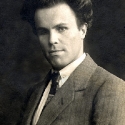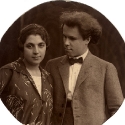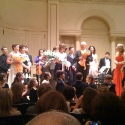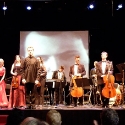 Petko Staynov (December 1, 1896 in Kazanluk – June 26, 1977) was a Bulgarian composer and pianist who played a pivotal role in the development of a Bulgarian musical style after five centuries of Ottoman occupation during which time Bulgaria had had very little exposure to Western musical culture. His symphonic compositions ,written during the first half of the 20th Century, were in part indebted to the Western and Russian tradition of Classical Romantic music. However, his homeland was the source of his uniqueness – these compositions were anchored in Bulgarian folk songs and poetry, and they marked the beginning of classical Bulgarian music.
Petko Staynov (December 1, 1896 in Kazanluk – June 26, 1977) was a Bulgarian composer and pianist who played a pivotal role in the development of a Bulgarian musical style after five centuries of Ottoman occupation during which time Bulgaria had had very little exposure to Western musical culture. His symphonic compositions ,written during the first half of the 20th Century, were in part indebted to the Western and Russian tradition of Classical Romantic music. However, his homeland was the source of his uniqueness – these compositions were anchored in Bulgarian folk songs and poetry, and they marked the beginning of classical Bulgarian music.
A composer of great musical talent with a broad knowledge of both musical and general culture, Petko Staynov possessed a keen sense of the topical ideas of modern Bulgaria, and saw music as playing a central unifying role in the shaping of Bulgaria’s emergent national identity. Finally he was and continues to be an extraordinary role model. A generous and compassionate man, he overcame significant physical limitations and with a steadfast drive and purposefulness he dedicated his entire life and all his abilities to improving Bulgarian music and musical culture.
Petko Staynov was born in Kazanluk to a family that had long been involved in textile manufacturing. After an accident, at the age of six, he lost the sight in one eye. Tragically, his other eye had also been affected by the injury and by the age of eleven he had lost his sight completely. While he lived in darkness the rest of his life, his visual memories from his early childhood remained ingrained in his consciousness. They played an important role in the content and form of his later artistic explorations and his special attachment to the “homeland.” Many of these early impressions were rooted in village life, which Petko encountered as a child during his summer vacations on his grandfather’s farm in the heart of the Rose Valley. Gypsy life and folk dancing during harvest time were to be a life long source of inspiration. Shortly after his accident Staynov enrolled in the Institute of the Blind in Sofia as a fulltime boarder until the age of 19. It was during his time at the Institute that he discovered the extent of his musical abilities and found a community that not only fostered his talent as a musician but also encouraged him to pursue composition. He learned to play the flute, the violin and the piano and was introduced to classic and romantic West European music. He studied music with Andrei Stoyanov, one of the most famous teachers in Bulgaria, read literature extensively in Braille and made initial attempts at composing.
Staynov graduated from the Institute of the Blind in 1915 and returned to Kazanluk where he stayed until the end of WWI. This was a tumultuous time for Bulgaria and the other Balkan states. WWI came at the heel of the two Balkan wars during which time Bulgaria fought to establish and safeguard its boundaries and achieve the complete withdrawal of the Ottomans from the Balkan Peninsula. During these years as a young man in Kazanluk, Staynov emerged as a natural leader and organizer who was committed to the spread of music in local communities. He coordinated and conducted a mixed choir at the Kazanluk’s community center and soon thereafter formed a quartet with three like-minded musicians. These initiatives evolved into a grass root undertaking that brought music to neighboring towns, which added to the already existing performance of the military brass bands and allowed Petko Staynov to hone his skills as a conductor and concert pianist. He also composed his first works: Fantasia for Piano and Violin as well as choral works. Staynov never forgot this early involvement with the musical life of communities. Through out his career as a musician and administrator, he put particular emphasis on establishing music centers in local communities throughout Bulgaria.
In 1920 he left for Germany for a year of studies at the Private Musical Lyceum in Braunschweg. In 1923 he graduated from the Dresden Musical Conservatory, majoring in composition under Alexander Wolf and in piano under Ernst Munch. There is evidence that he performed as a pianist in Germany for a short time before going back to Bulgaria. His blindness certainly shaped the direction of his career. During his time in Germany, Staynov took full advantage of the extensive musical and even visual culture that surrounded him –he attended concerts almost daily and would go to museums and have the paintings described to him either by his brother or his future wife. Nevertheless, his visual memories were only of Bulgaria and that is where he felt the most at ease. Unlike other Bulgarian composers who sought an international career, in part because of his blindness, Staynov directed all his energies towards his homeland. Returning from Germany, he stopped in Vienna where his father had been hospitalized. After receiving his father’s blessing Petko married his childhood friend, Stephanka who had joined him earlier in Germany after studying music at the Vienna Conservatory.
Having returned to Kazanluk in 1925, he composed his first major work: the Thracian Dances symphonic suite in three movements built around folk-tempi and rhythms to which a fourth movement, Mechkarsko, was added in 1926. The last part of the suite, Rachenitsa, has been played worldwide and is considered to be the first classical adaptation of the original Bulgarian dance of the same name. Here he directly quotes popular themes for the first and last time. In his subsequent works he would author new motifs in the spirit of the Bulgarian folklore creating music that is new and original and yet deeply familiar to his audience.
In 1927 he moved to Sofia and began teaching piano at the Institute for the Blind. Petko Staynov would work mainly in the genres of symphonic and choral music.
Works
Staynov’s symphonic output includes the suites Thracian Dances (1925, 1926) and A Fairy Tale (1930), the symphonic poems A Legend ( 1927) and Thrace ( 1937), Symphonic Scherzo (1930), the concert overtures Balkan and Youth Overture (1936 and 1953), two symphonies First Symphony in A minor and Second Symphony in C minor( 1945 and 1949). His work attuned the European musical tradition to the Bulgarian way of thinking. From the Western European musical tradition Staynov adopted expressive devices and forms – the construction of a well-crafted structure and the resources of the symphony orchestra. He introduced a novel and singular Bulgarian musical style rooted in Bulgarian folk music with its references to epic poetry and unique asymmetric rhythm.
Staynov’s earliest symphonic work achieved for the first time in Bulgaria a unified symphonic structure, development and musical language. Ranging from the melodious and lyrical to the epic and heroic, and at times dynamic and culminating in the jubilant, Staynov’s symphonic suites and poems transcend the particularities of the folk songs to capture the essence of Bulgaria: its land, mythology, and musical tradition. They speak of the beauty of his native land, the fervor of folk dances, and the poetic imagery of its fairy tales; so much so that two of his works, Thracian Dances and Thrace have become iconic pieces within Bulgarian classical music. His two symphonies, one completed at the end of World War II and the second one after the establishment of communist rule, address broader philosophical themes and reflect the concerns of the times. They further develop the epic quality of his earlier compositions. Petko Staynov’s music was grounded in the particular circumstances of his life, his country and his time. These were the source of both the original and universal quality of his compositions.
They evoked universal feelings of pain, suffering, and hope embedded in the national context.
Petko Staynov’s choral songs reveal features of the Bulgarian people’s character ( A Fir Tree is Bending; A Bright Sun Has Risen; Hey, Ivan; Play a Tune, Dimo; Oh, That Man Dimo; Hey, Dimo). Until the early 1930’s, he followed the traditions of choral art established by the first composers in the genre, introducing at the same time elements of his own style.
By the early 30’s, however, Staynov’s choral ballads laid the foundation for a whole new genre in Bulgarian music. These works/compositions mainly recreated dramatic events from Bulgaria’s old and recent history and thus achieved a national ballad sound, which fused fairy-tale and fantastic elements with realistic and folk ones. (e.g. The Secret of Struma River, 1931; Urvich for mixed choir on lyrics by N. Rakitin, 1933; Horsemen, 1932; One Hundred and Twenty Men for male choir on lyrics by P.P. Slaveykov, 1935; A Maiden’s Lament for mixed choir on lyrics by T. Kunev, 1936; Comrade Anton for mixed choir on lyrics by I. Radoev, 1954; Godfather German for mixed choir on lyrics by D. Panteleev, 1955.) Staynov’s ballads pose technical difficulties for their performers and remain to the present day a touchstone for the performing mastery of Bulgarian choirs.
Public Office
Petko Staynov like several other composers of his generation felt that the state of Bulgarian music required serious improvement and that it was essential to raise the standing of the Bulgarian musical community. Staynov emerged as the natural leader of this effort because of his ability to rise above the often- dissenting composers and musicians, to forge a consensus and to take constructive steps in a positive direction. He held the chair of the Union of Folk Choirs in Bulgaria ( the Bulgarian Singing Union) and of the Contemporary Music Association of Bulgarian Composers (1933-44). Chosen by the then King of Bulgaria, Boris, he also served as Director of the National Opera (1941-44). In 1941 he was elected Regular Member (Academician) of the Bulgarian Academy of Sciences and in 1948 he became Director of the newly founded Institute for Music (later the Institute of Musicology) and held this position to the end of his days. He was also member of the Presidium of the Bulgarian Academy of Sciences and Academician-Secretary of the Department of Arts and Culture at the Bulgarian Academy of Sciences. Under his wise and competent direction, these institutions, unions, associations and other organizations reached the highest levels of their achievements.
Petko Staynov’s ideas about the social functions of music, the significance of folk music for the creativity of Bulgarian composers, the creation of a Bulgarian musical style, choral singing, school musical education, to name a few have been recorded in numerous articles, most of which were published in the collection Petko Staynov: On Bulgarian Musical Culture, 1967. He held numerous high state awards. He died on June 26, 1977.




